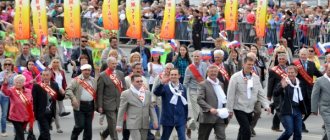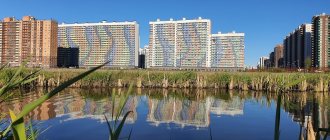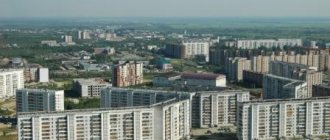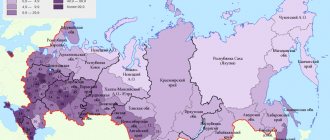For other uses, see Susuman (disambiguation).
Town in Magadan Oblast, Russia
| Susuman Susuman | |
| City [1] | |
| View of central Susuman | |
| Flag Coat of arms | |
| Location of Susuman | |
| Susuman Location of Susuman Show map of Russia Susuman Susuman (Magadan region) Show map of Magadan Oblast | |
| Coordinates: 62°47'N 148°10'E / 62.783°N 148.167°E / 62.783; 148.167 Coordinates: 62°47'N 148°10'E. / 62.783°N 148.167°E / 62.783; 148.167 | |
| A country | Russia |
| Federal subject | Magadan region [1] |
| Administrative region | Susuman district [1] |
| Based | 1936 |
| City status from | 1964 |
| Height | 650 m (2130 ft) |
| Population (2010 Census) [2] | |
| • General | 5,855 |
| • Evaluate (2018) [3] | 4760 ( -18,7% ) |
| Administrative status | |
| • Capital from | Susuman district [1] |
| Municipal status | |
| • Municipal district | Susuman municipal district [4] |
| • Urban village | Urban settlement Susuman [4] |
| • Capital from | Susuman municipal district [5], urban settlement Susuman [4] |
| Timezone | UTC+11 (MSK+8[6]) |
| Postal code [7] | 686314 |
| Dialing code(s) | +7 41345 |
| OKTMO ID | 44713000001 |
| Web site | WWW .magadan .ru / RU / municipal / rnsusuman / Susuman .html |
Susuman
(Russian: Susuman) is a city and the administrative center of Susumansky District in Magadan Oblast, Russia, located on the Berelyokh River, 650 km (400 mi) northwest of Magadan, the administrative center of the region. Population: 5,855 (2010 census); [2] 7,833 (2002 census); [8] 16,818 people (1989 census). [9]
History[edit]
It was founded in 1936 as a settlement on a state farm called Susuman
, named after the nearby river of the same name.
[ citation needed
] In 1938, the settlement was significantly expanded and became a gold mining center in the western part of what is now the Magadan region, under the control of Dalstroi.
Gold mining and other industrial operations in the region relied heavily on the forced labor camps of the Gulag system, many of which operated in the vicinity of Susuman. From 1949 to 1956, Susuman was the base of one of the largest forced labor camps in the Soviet Union - Zaplaga
Dalstroy programs. During this time, up to 16,500 prisoners were kept in the camps.
Susuman received city status in 1964. [ Citation needed
] During the post-Soviet period, the population decreased significantly from 18,000 inhabitants in 1991 to 5,855 according to the 2010 census.
Climate[edit]
Susuman has an extreme dry winter subarctic climate (Köppen climate classification DWD/DWC
) with very cold, dry winters and short, very mild summers. It is one of the coldest permanently inhabited places in the world, with an average annual temperature of −12.5 °C (9.5 °F).
| Climate data for Susuman (1937-2012) | |||||||||||||
| Month | Jan | Feb | Mar | Apr | Maybe | Jun | Jul | Aug | Sep | October | But I | December | Year |
| Record high °C (°F) | -5,2 (22,6) | -5,2 (22,6) | 0,2 (32,4) | 12,1 (53,8) | 26,1 (79,0) | 32,0 (89,6) | 35,0 (95,0) | 33,0 (91,4) | 24,4 (75,9) | 11,3 (52,3) | 2,1 (35,8) | -1,6 (29,1) | 35,0 (95,0) |
| Average high °C (°F) | -33,7 ( -28,7 ) | -28,2 (-18,8) | -17,6 (0,3) | -4,9 (23,2) | 8,0 (46,4) | 18,6 (65,5) | 21,2 (70,2) | 17,7 (63,9) | 8,7 (47,7) | −8 (18) | -25,2 ( -13,4 ) | -33,6 (-28,5) | -6,4 (20,5) |
| Daily average °C (°F) | -37,9 (-36,2) | -33,6 (-28,5) | -25,4 ( -13,7 ) | -12,7 (9,1) | 1,9 (35,4) | 11,2 (52,2) | 13,9 (57,0) | 10,6 (51,1) | 2,8 (37,0) | -13,6 (7,5) | -29,7 (-21,5) | -37,5 (-35,5) | -12,5 (9,5) |
| Average low °C (°F) | -42,1 (-43,8) | -39 (-38) | -33,1 ( -27,6 ) | -20,5 (-4,9) | −4,3 (24,3) | 3,8 (38,8) | 6,5 (43,7) | 3,4 (38,1) | −3,2 (26,2) | -19,2 (-2,6) | -34,2 ( -29,6 ) | -41,4 ( -42,5 ) | -18,6 (-1,5) |
| Record low °C (°F) | -60,6 (-77,1) | -59,9 (-75,8) | -53,7 (-64,7) | -44 (-47) | -27,5 (-17,5) | -8,8 (16,2) | -4,1 (24,6) | -11,1 (12,0) | -24,3 (-11,7) | -44,7 ( -48,5 ) | -53,8 (-64,8) | -58,5 (-73,3) | -60,6 (-77,1) |
| Average precipitation, mm (inches) | 9,0 (0,35) | 7,2 (0,28) | 4,3 (0,17) | 5,8 (0,23) | 13,7 (0,54) | 44,6 (1,76) | 58,3 (2,30) | 58,5 (2,30) | 30,6 (1,20) | 16,5 (0,65) | 11,6 (0,46) | 10,7 (0,42) | 270,8 (10,66) |
| Average number of days with precipitation (≥ 0.1 mm) | 13,9 | 11,8 | 8.1 | 6.1 | 7,4 | 12,7 | 13,7 | 13,2 | 10.2 | 11,6 | 13,5 | 13,1 | 135,3 |
| Average sunshine hours per month | 20 | 89 | 213 | 283 | 273 | 291 | 274 | 223 | 152 | 132 | 53 | 10 | 2,013 |
| Source: climbase.ru (1937-2012) [10] | |||||||||||||
Links[edit]
Notes[edit]
- ^ abcde Law No. 1292-OZ
- ^ a b Federal State Statistics Service (2011). All-Russian Population Census 2010. Volume 1 [All-Russian Population Census 2010, vol. 1]. All-Russian Population Census 2010 [All-Russian Population Census 2010] (in Russian). Federal State Statistics Service.
- "26. The size of the permanent population of the Russian Federation by municipalities as of January 1, 2021". Federal State Statistics Service. Retrieved January 23, 2021.
- ^ abcd Law No. 512-OZ
- Law No. 511-OZ
- "On the Calculation of Time". Official Internet portal of legal information
. June 3, 2011. Retrieved January 19, 2021. - Post office. Information and computing center of OASU RPO. ( Post office
).
Search for postal service objects ( postal Search for objects
) (in Russian) - ↑
Federal State Statistics Service of Russia (May 21, 2004). The population of the Russian Federation, cities of the Russian Federation as part of federal districts, urban settlements, settlements, settlements, settlements is 3 thousand or more people. [Population of Russia, its federal districts , subjects of the Federation, districts, urban settlements, rural settlements - administrative centers and rural settlements with a population of more than 3000 people] (XLS). All-Russian Population Census of 2002 [All-Russian Population Census of 2002] (in Russian). - All-Union Population Census of 1989 Population of Union and Autonomous Republics, Autonomous Regions and Districts, Territories, Regions, Urban Settlements and Village District Centers [All-Union Population Census of 1989: Current Population of Union and Autonomous Republics, Autonomous Regions and Districts, Territories, Regions , districts, urban settlements and villages performing the functions of district administrative centers]. All-Union Population Census of 1989 [All-Union Population Census of 1989] (in Russian). Institute of Demography of the National Research University: Higher School of Economics [Institute of Demography of the National Research University: Higher School of Economics]. 1989 - via Demoscope Weekly
. - "Climatebase.ru" (in Russian). Retrieved February 15, 2017. CS1 maint: discouraged parameter (link)
Sources [edit]
- Magadan Regional Duma. Law No. 1292-OZ of June 9, 2010 “On the administrative-territorial structure of the Magadan Region,” as amended. Law No. 1756-OZ of June 9, 2014 “On Amendments to the Law of the Magadan Region” On the Administrative-Territorial Structure of the Magadan Region “”. Came into force 10 days after the day of official publication. Published: Supplement to the newspaper “Magadanskaya Pravda”, No. 63 (20183), June 16, 2010 (Magadan Regional Duma. Law No. 1292-OZ of June 9, 2010 “ On the administrative-territorial structure of the Magadan Region”
as amended Law No. 1756-OZ of June 9, 2014 “
On Amendments to the Law of the Magadan Region “On Administrative Management”).
-Territorial structure of the Magadan region" . Valid from the day that is 10 days after the official date of publication.). - Magadan Regional Duma. Law No. 511-OZ of December 28, 2004 “On the borders and status of municipalities in the Magadan region,” as amended. Law No. 1887-OZ of April 8, 2015 “On the transformation of the municipalities “Ust-Omchug village”, “Omchak village”, “village named after. Gastello”, “Madaun village” by merging them with the status of an urban district”. Effective as of December 31, 2004, except for provisions that have different effective dates. Published: “Magadanskaya Pravda”, No. 146 (19370), December 29, 2004 (Magadan Regional Duma. Law No. 511-OZ of December 28, 2004 “ On the borders and status of municipalities in the Magadan Region”
as amended by the Law No. 1887-OZ dated April 8, 2015
On the transformation of the municipalities “Ust-Omchug Village”, “Omchak Village”, “Gastello Village”, “Madaun Village” by merging them and giving them the status of an urban district
... Valid from December 31 2004, except for paragraphs that have different effective dates). - Magadan Regional Duma. Law No. 512-OZ of December 28, 2004 “On the borders and status of newly formed municipalities in the Magadan region,” as amended. Law No. 1887-OZ of April 8, 2015 “On the transformation of the municipalities “Ust-Omchug village”, “Omchak village”, “village named after. Gastello”, “Madaun village” by merging them with the status of an urban district”. Came into force on December 31, 2004. Published: “Magadanskaya Pravda”, No. 146 (19370), December 29, 2004 (Magadan Regional Duma. Law No. 512-OZ of December 28, 2004 “On borders and status again formed municipalities in the Magadan region"
as amended by Law No. 1887-OZ of April 8, 2015
On the transformation of the municipalities "Ust-Omchug Village", "Omchak Village", "Gastello Village", "Madaun Village" by merging them and giving them the status of a city district
... Effective from December 31, 2004).
Roads to the sky of Kolyma: Susuman Airport (Berelyokh)
Vasily Obraztsov has been writing about our city and region for a long time. About its history, its present and future. The blogger shows its beauty, fate, people. A joint project of the news agency MagadanMedia and the website “My Motherland is Magadan” - a new look at native places.
The village of Berelekh is a village of motor transport workers. In 1936, the Berelekh car depot was created, which in the best years of its activity had hundreds of powerful cars in its fleet. The motor depot vehicles worked throughout Kolyma, delivering fuel, food, and equipment.
It is now difficult to say exactly when air communication with Berelyokh began, but on the maps of air routes of the Dalstroy trust, the Berelyokh airfield was already in 1935-1937. So the Bereleh airfield at that time already existed and worked as an air harbor.
Dalstroy Trust Airline Scheme. 1935-1937. Photo: kolymastory.ru
The Bereleh airfield was actively used until 1941, and the number of routes and flights increased. The Berelekh airfield was of no small importance for central Kolyma.
Route diagram of the Dalstroy air squad for 1941. Photo: kolymastory.ru
From the documents: “In the summer of 1940, Dalstroy aviators were given a new task to deliver uniforms, various materials, products for geologists to Omsukchan, Zyryanka, Motley Dresva, Nera and Lake Darpir, and to ensure uninterrupted delivery of newspapers and correspondence to Southern, Western, Northern and other departments. Soon regular flights were carried out along the already developed air routes Magadan - Zyryanka, Magadan - Ust-Nera, Magadan - Berelekh, Magadan - Nayakhan, etc...."
The construction of the new airport Susuman owes to the Great Patriotic War, to be precise - to the AlSib highway.
On October 9, 1941, the State Defense Committee decided to organize the delivery of aircraft from the USA to the USSR by air. The creation of this route was entrusted to the Main Directorate of the Civil Air Fleet under the command of Major General V.V. Molokov. Several different routes were studied, and the path through the Bering Strait, the central regions of Chukotka and Yakutia to Krasnoyarsk was chosen. D.E. was appointed head of the airline's construction. Chusov. On October 13, the first group of specialists was formed, and on the 16th, it flew to Irkutsk.
Nikolai Yakovlevich Filippovich. Photo: kolymastory.ru
Nikolai Yakovlevich Filippovich. Since 1939, he worked as an AMSG weather forecaster. Berelyokh Nikolai Yakovlevich Filippovich was on the route from the beginning of its construction until the completion of its activities. He recalled: “On one autumn day in 1941, a twin-engine R-6 plane landed at Bereleh airport late in the evening. Having finished my duty as a weather forecaster, I went out to look at the passengers. Among them was my old friend Veprov. The pleasant meeting made it easier to clarify the questions that interested me. The passengers of the flight turned out to be a commission of the State Defense Committee, headed by Dmitry Evdokimovich Chusov, for the construction of a special air route Krasnoyarsk - Uelkal. The commission included specialists in the construction of airfields and airfield structures, and a number of future airport managers. In particular, the head of the future airport was Seymchan Samokhvalov, and Veprov soon became the head of the Berelyokh airport.”
Dalstroy NKVD was entrusted with the construction of two base airports - Seymchan and Uelkal, as well as reserve airfields Oymyakon, Zyryanka and Berelekh (Susuman). This accounted for the lion's share in the creation of the first stage of AlSib.
According to the orders received, the Dalstroy air squad transferred from its subordination to the Special Line of the Civil Air Fleet (ferry route "AlSib") the Berelekh airport as of December 1, 1941 and the Zyryanka airport as of January 1, 1942.
Pilot Komarov Petr Tikhonovich. Photo: kolymastory.ru
In the spring of 1942, planes carrying construction workers and cargo began flying. One of the first pilots to fly along the route is considered to be the commander of the Li-2 aircraft, P.T. Komarov, who in April transferred builders and the first radio operators with radio equipment to the Aldan, Berelekh and Seymchan airfields under construction
Construction work was mainly carried out by hand, with shovels and picks; gravel for the runways was carried out on horses and compacted with mallets. Nevertheless, the first stage of the Krasnoyarsk air route was built in ten months. The report of the acceptance committee states that by the beginning of October 1942, 10 airfields were opened on the route: the previously operating Krasnoyarsk and Yakutsk and 8 new ones. The base ones are Kirensk, Seymchan and Uelkalb, the intermediate and reserve ones are Aldan, Olekminsk, Oymyakon, Berelekh (Susuman) and Markovo. Also, alternate airfields with unpaved airfields are being built - Bodaibo, Vitim, Ust-Maya, Khandyga, Zyryanka, Anadyr. Some of them are only for winter use.
Thus, thanks to the Alsib highway, the airport from the village of Berelekh, after the construction of a dirt strip, the creation of airport infrastructure (buildings of technical services, boxes for ground equipment, a hotel, an administrative building with a control tower, an air terminal, etc.) moved to a permanent place of residence near the village Susuman.
In the haste of research, there were some mistakes. From the report of the Civil Air Fleet State Administration commission for the inspection and acceptance into operation of airfields on the Krasnoyarsk air route (November 1942): “The Bereleh reserve airfield... is suitable for receiving all types of aircraft. But due to the construction of the intermediate airfield Oymyakon in the third quarter of 1942, the significance of Berelyokh was reduced to a reserve site. If we take into account... - up to 40% of the year there are fogs and clouds... the constraint of approaches by the surrounding mountains, then the costs for the Bereleh airfield should be considered... unjustified. This is the result of poor organization of surveys and unreasonable selection of sites throughout the Seymchansky junction...”
From the beginning of 1943, all units and divisions of the Main Directorate of the Civil Air Fleet of the USSR were gradually assigned standard, five-digit numbers of military units, the last of which were canceled only in 1947. Berelekh Airport of the Krasnoyarsk-Uelkal Civil Air Fleet Air Route Administration was assigned the number 78727-T.
In May 1944, US Vice President Henry Wallace arrived in Magadan via the Krasnoyarsk-Uelkal air line serviced by the 1st Ferry Air Division of the Civil Air Fleet. He visited enterprises and institutions in Kolyma, including getting acquainted with the work of Seymchan and Berelyokh airports.
From the memoirs of Henrietta Alanova: “Not far from our hut was the Berelyokh airfield. My brother and I climbed onto the logs laid along the fence for firewood and watched the planes take off and land. Sometimes planes landed on their bellies, and sometimes they crashed. Therefore, in the yard, having trained parts from damaged cars, we assembled our own, almost real, plane. My brother was the “pilot” and I was the “navigator”.
One day we happened to witness a disaster. I remember a dark green plane with a red star and a fallen wing, on which lay a man in khaki overalls. Smoke, fumes, something red on the bushes... There were no survivors of the disaster. We were sent home, and people who came running from the village quickly dug up the accident site. Then at this place we found a lot of burnt money. The dead were pilots ferrying planes to the front from America through Siberia. This time they returned home, having received payment for their work. And this is such a tragedy...”
After the Great Patriotic War, the importance of the new Berelekh (Susuman) airport for life and development of central Kolyma only increased.
From the memoirs of Evgeniy Krasheninnikov (1958): “The Berelyokh airport served as an air gate to the center of the Kolyma outback and was located 8 kilometers from a small urban-type village called Susuman.”
I want to make it clear right away that Evgeniy Evgenievich Krasheninnikov in his memoirs indicates the distance between the airport and the village is 8 kilometers, which in fact does not correspond much to reality. Unfortunately, this mistake is replicated by many publications and websites...
Scheme from the report on the crash of the L-14 Super Electra of the Dalstroy air squad of the USSR Ministry of Internal Affairs near Berelyokh. Photo: kolymastory.ru
According to the diagram from the report, we can say that the distance between the village of Susuman and the new Bereleh airport in 1946 was no more than 2-3 kilometers.
Bereleh Airport. August, 1966. KDP (command and control center). Photo: kolymastory.ru
For some time the airport was called “Bereleh”, and then it was renamed “Susuman” airport. Unfortunately, I do not know the exact date of renaming the airport.
The building of the Susuman (Bereleh) airport after the renaming. Now on the sign - Susuman. Photo: kolymastory.ru
In 1957, the airport Susuman (Berelyokh) was assigned class 3. Quote: By order of the Main Directorate of the UVF dated July 22, 1957. No. 065 Magadan separate air group was separated from the Far Eastern TU Civil Air Fleet and became directly subordinate to the Main Directorate of the Civil Air Fleet. It consists of: 185, 150 and 194 aviation detachments; 3rd class airport Berelekh, 4th class airports Magadan - 47 km. B. Lavrentiya, Uelkal, B. Provideniya, Markovo, Gizhiga, Kamenskoye, Omsukchan, Severo-Evensk, Bay of the Cross, Kedom, Pevek, Baykovo, Penzhino, Tanyurer, Omolon; Aircraft repair shops ARM 73; air rescue squadron.
The dirt strip (the best option in permafrost conditions) provided the reception and dispatch of An-2, Il-14, then An-24, An-26, An-30, Yak-40, L-410. The airport was open at any time of the year and even in severe frosts, when it was -69 outside. The workhorses of Aeroflot (USSR), for example, the Il-14 and An-24, performed excellently in harsh northern conditions and provided residents of the Kolyma Territory with air communication with the regional center - Magadan and with the “mainland”.
An-24 comes in for landing at Susuman airport. Photo: kolymastory.ru
Along with passenger air transportation to Susuman, An-26 cargo flights were carried out, transporting a wide range of cargo - from needles to equipment for mines. It was with the development of the area that, to ensure this development, a project was begun to build a runway for aircraft of a larger tonnage than the An-26. In the late eighties, there was a project to build a new, larger runway at the airport in Susuman to receive aircraft such as Tu-134, An-12, and the project began to be implemented in those days, work began on preparing and filling the runway... but with with the collapse of the Union everything died out...
The period from 1998 to 2012 was probably the most difficult test for the airport. The airport went through bankruptcy proceedings and was removed from the airport register. Abandoned and abandoned by people, it began to collapse.
During the period of inactivity from 1998-2012, helicopters only flew sporadically to Susuman. Photo: kolymastory.ru
At this time, helicopters flew sporadically to Susuman, mainly to ensure the operation of the television repeater.
Susuman Airport during a period of inactivity from 1998-2012. The airport's dirt runway is in disrepair. Photo: kolymastory.ru
The airport runway became overgrown with grass and became unusable.
Former airport hotel Susuman (Bereleh). Photo: kolymastory.ru
The buildings of the airfield complex fell into disrepair and were dismantled.
In 2001, part of the buildings of the Susuman airport were transferred to the Russian Orthodox Church for the organization of the monastery of Sergius of Radonezh. Thanks to this, the flight control tower building at Susuman Airport survived.
Flight control tower at Susuman Airport (Bereleh). Now one of the buildings of the monastery of Sergius of Radonezh. Photo: kolymastory.ru
The building of the former Susuman Airport Hotel was cleaned up and restored.
The building of the former airport hotel Susuman (Bereleh). Now one of the buildings of the monastery of Sergius of Radonezh. Photo: kolymastory.ru
By the way, I don’t presume to say 100 percent, but the hotel building in Susuman is very similar in architecture to the Seymchan Airport hotel building, built during the time of Alsib. It may also turn out that the building of the Susuman airport hotel was erected during the construction of the Bereleh airfield, as the Alsiba airfield, and has a certain historical value.
Even if it's not true. then I want to express my gratitude to the Russian Orthodox Church for saving such a beautiful log building from destruction and destruction, and there are not so many of them left...
Susuman Airport began its second life in 2011. In order to resume flights, it was first necessary to prepare design estimates for the reconstruction of the landing strip. As the head of the Susumansky district, Alexander Kurshev, said, the chairman of the board of directors of OJSC Susumanzoloto, Vladimir Khristov, took upon himself the solution to this issue.
Surveys were carried out, the necessary documentation was drawn up, and in the summer of 2011 work began to prepare the airport for receiving aircraft. Last year, during the reconstruction of the strip, 128 thousand cubic meters of inert materials were poured. The construction was financed by the Susumansky and Berelekhsky GOKs; the total cost amounted to more than 70 million rubles. Completion of the construction of the strip with airfield sites was scheduled for July 2012.
Also, the Magadan-Susuman route was included in the list of subsidized routes, and a competition was announced for flights in this direction, which took place on June 26, 2012. Initially, the flights were planned to be carried out on An-28 type aircraft with a frequency of one flight per week, and, in case of demand, it is possible to increase the intensity of flights. The population of the area was also looking forward to the start of flights. Susumansky district is the most distant from the regional center, travel time by road is 12-16 hours, a one-way flight is 1.5 hours, and the cost of an air ticket is approximately 3000-4000 rubles.
An-28 comes in for landing at Susuman airport. Photo: Photo by Yuri Slyunkov
Twenty-seventh July 2012. In the life of Susuman residents, the execution of a technical flight on the Magadan - Susuman route became an equally important and long-awaited event. This northern airfield last received planes almost ten years ago - in 2003. Having completed a circle over the airfield, the AN-28 gently touches the runway with its wheels. Enthusiastic shouts of “Hurray!” and applause - a reward for the residents and the skill of the pilots, and most importantly for those who were directly involved in the revival of air traffic with the regional center.
Flights began to operate five times a week on weekdays. Flights have so far been carried out only according to actual weather conditions. In order for the winged technology to stop depending on the vagaries of the weather, a radio beacon was expected to be installed in 2013.
In the future, it is planned to lengthen the runway by 200 m for new aircraft and install a new airport building (a small one, to be sure) with a storage area for passengers and inspection equipment.
External links [edit]
- Official website of Susuman (in Russian)
- Unofficial site of Susuman (in Russian)
- The documentary film *** GOLD *** - Lost in Siberia
[3] by Gerard Jacobs and Theo Wittenbogaard (VPRO / The Netherlands / 1994) was filmed in the summer of 1993 in Magadan, along
the Road of Bones
, through Ust-Umshug and Susuman and on Gold Sverovostok Gold mine in Siberia was the first ever foreign film crew to visit the Kolyma region, which for more than 60 years was under the control of the Soviet secret service called Dalstroy.
| vteAdministrative divisions for the Magadan region | |||
| Administrative center: Magadan • Rural area. | |||
| Districts |
| ||
| Cities and towns |
| ||
| Urban settlements |
| ||
Map
| Susuman: maps |
Susuman: photo from space (Google Maps) Susuman: photo from space (Microsoft Virtual Earth)
| Susuman. Nearest cities. Distances in km. on the map (in brackets along roads) + direction. Using the hyperlink in the distance , you can get the route (information courtesy of the AutoTransInfo website) | |||
| 1 | Yagodnoe | 80 (108) | IN |
| 2 | Ust-Omchug | 200 (319) | YU |
| 3 | Seymchan | 215 (465) | IN |
| 4 | Ust-Nera (Republic of Sakha (Yakutia)) | 313 (382) | NW |
| 5 | Tent | 332 (499) | SE |
| 6 | Zyryanka (Republic of Sakha (Yakutia)) | 353 () | NE |
| 7 | Magadan | 384 (581) | YU |
| 8 | Omsukchan | 390 (586) | IN |
| 9 | Ola | 394 (611) | SE |
a brief description of
Located on the river. Boryolekh (Kolyma basin), on the Kolyma tract, 650 km northwest of Magadan.
Territory (sq. km): 46766
Information about the city of Susuman on the Russian Wikipedia site
Historical sketch
At the end of the summer of 1936, a new estate was laid for the Elgen state farm of the Northern GPU Dalstroy. Called after the river. Susuman. The hydronym from Even kuhuman “blizzard, drifting snow, wind”, in a distorted form Susuman, was first put on the map in 1929 (expedition of S.V. Obruchev).
In August 1937, the first gold mine in the region, Maldyak, was organized. In 1938, the Western Mining Department of Dalstroy was organized with its center in the village of Susuman.
In 1953, the Susumansky district of the Magadan region was formed. On December 12, 1964, the working village of Susuman was transformed into a city.
Economy
Mining and processing plant (gold mining).
Factories: mechanical repair, building materials. Motor transport enterprises, meat and dairy plant. Vegetable and dairy state farm.
In the Susuman region, mainly vegetables are grown. Cattle are raised.
Deposits of gold, coal, silver, tin, tungsten, mercury.
Main enterprises
COAL INDUSTRY
OJSC Open-pit mine "Kadykchansky", branch of OJSC "Kolyma Coal Susumansky GOK 'Susumanzoloto'"
686310, Magadan region, Susuman, st.
Pervomayskaya, 5a Offers:
gold, silver
| Population by year (thousands of inhabitants) | |||||||
| 1959 | 13.3 | 2000 | 8.9 | 2010 | 5.8 | 2017 | 4.9 |
| 1970 | 12.6 | 2001 | 8.8 | 2011 | 5.9 | 2018 | 4.8 |
| 1979 | 16.0 | 2003 | 7.8 | 2012 | 5.6 | 2019 | 4.6 |
| 1989 | 16.8 | 2005 | 7.2 | 2013 | 5.3 | 2020 | 4.4 |
| 1992 | 15.1 | 2006 | 6.9 | 2014 | 5.2 | 2021 | 4.3 |
| 1996 | 10.4 | 2007 | 6.5 | 2015 | 5.0 | ||
| 1998 | 9.6 | 2008 | 6.3 | 2016 | 4.9 | ||









